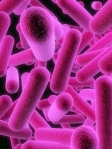E. Coli is not gone. In our standard, American way, we have somehow forgot the small little pathogen that killed four hamburger-eating children in 1994. We tend to remember it only when it makes headlines, such as when it was recently found in chocolate chip cookie dough. Once you  think about where e. Coli comes from, you’ll wonder just how it got…THERE.
think about where e. Coli comes from, you’ll wonder just how it got…THERE.
I’m grateful to my friend Mike, who sent me the following article: http://www.nytimes.com/2009/10/04/health/04meat.html?_r=1&th&emc=th . The article, from the New York Times, details one woman’s fight with e. coli – a fight which left her paralyzed.
Here’s the short list of what to remember about e. coli and hamburger meat – and any other e coli containing material:
- E coli bacteria are found in the intestinal tracts of all warm blooded animals (mammals and birds) and are naturally occuring. It is only when they become infected with a Shinga virus that they become deadly to humans – producing what is known as the Shinga toxin.
- Although E. coli O157:H7 is responsible for the majority of human illnesses attributed to E. coli, there are additional Stx-producing E. coli (e.g., E. coli O121:H19) that can also cause hemorrhagic colitis and post-diarrheal hemolytic uremic syndrome (D+HUS). HUS is a syndrome that is defined by the trilogy of hemolytic anemia (destruction of red blood cells), thrombocytopenia (low platelet count), and acute kidney failure.
- E. coli O157:H7 was first recognized as a foodborne pathogen in 1982 during an investigation into an outbreak of hemorrhagic colitis (bloody diarrhea) associated with consumption of contaminated hamburgers (Riley, et al., 1983). The following year, Shiga toxin (Stx), produced by the then little-known E. coli O157:H7, was identified as the real culprit.
- The CDC has estimated that 85% of E. coli O157:H7 infections are foodborne in origin (Mead, et al., 1999). In fact, consumption of any food or beverage that becomes contaminated by animal (especially cattle) manure can result in contracting the disease. Foods that have been sources of contamination include ground beef, venison, sausages, dried (non-cooked) salami, unpasteurized milk and cheese, unpasteurized apple juice and cider (Cody, et al., 1999), orange juice, alfalfa and radish sprouts (Breuer, et al., 2001), lettuce, spinach, and water (Friedman, et al., 1999). (Thank you Marler and Clark for the information!)
- A point about unpasteurized milk: raw milk from the cow does not contain pathogens. It is only when those products are produced in unclean, unsanitary facilities that the milk becomes infected…which will bring me to my last point –
- It should not be the responsibility of the public to prove their food “safe.” It should the the responsibility of the food producer to provide, as clean and healthy as possible, food for the purchasing public. It is also the responsibility of the cook/eater to prepare the food in as healthy a way as possible. Having said that, let’s start with good materials to begin with and go from there, shall we?
The questions we should all be asking ourselves are…
- How does a poop-borne pathogen end up in cookie dough? Think about it…
- If processed foods like cookie dough aren’t safe (and don’t contain any products that might have a HINT of manure), what is?
- How many cows does it take to make a ground beef patty? Do you know where your cow came from?
- If things were clean from the beginning, would we really have a problem with e coli?
- If cows ate the whole grass (not just the grain FROM the grass), would we really have a problem with e coli?
For these reasons, and a few more, I choose to purchase my own cow. And pig. One cow – one burger – one source. If you haven’t looked into a meat CSA, I highly recommend it. In Suburbia, it’s possible to do it with a group of friends. It’s not hard. It just takes a few of us at a time to make the change. Then, perhaps, big agra will listen to what we want – not the sound of money hitting their pocket lining.
It really is possible to know where our food came from on a grand, American scale, too. Check out the article linked here. The French have gone all out and done it with their own beef supply. Perfect? Maybe not – but it’s a step in the right direction.
Can’t we go there, too?
–Kris

 think about where e. Coli comes from, you’ll wonder just how it got…THERE.
think about where e. Coli comes from, you’ll wonder just how it got…THERE.